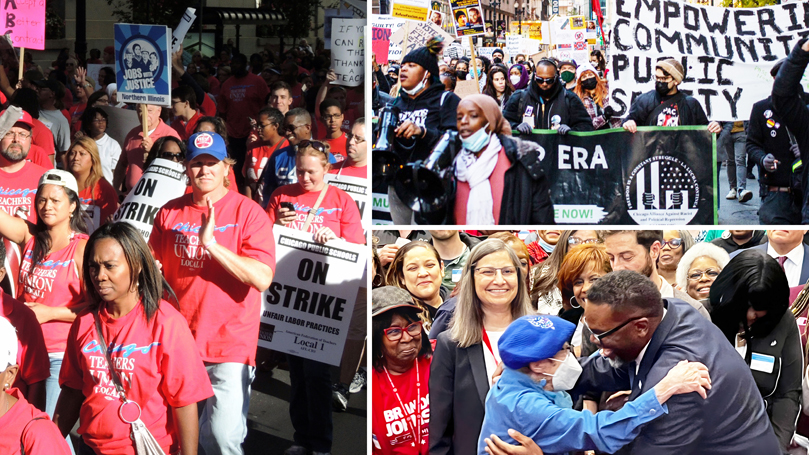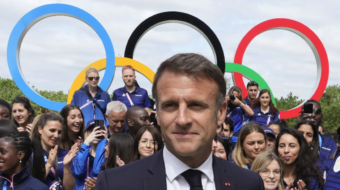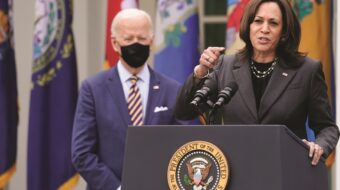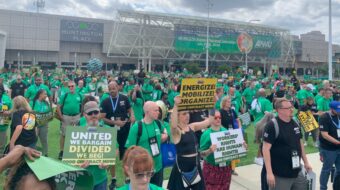
CHICAGO—Frank Chapman, chair of the National Alliance Against Racist and Political Repression (NAARPR), opened up a discussion at a conference of the Communist Party’s Labor Commission this weekend on how a progressive labor leader, Brandon Johnson, was elected mayor of Chicago earlier this year, defeating Paul Vallas, a powerful racist operative of the establishment.
Before getting into specifics, Chapman said it was important to understand that the United States, as a nation, was fundamentally flawed when it comes to the question of racism. “It’s a country that held that Black people were only three-fifths human,” he said, and which “still holds that today, in many respects.”
Chapman reminded the largely young crowd of communist and allied labor activists gathered at Unity Center in Chicago that Karl Marx tackled the question of racism in the first edition of Capital. Quoting the most famous critic of capitalism, Chapman said, “Labor in the white skin can never free itself as long as labor in the black skin is branded.” He reminded attendees that today “there is no path to socialism without taking the path to expose and defeat racism.”
He reminded those in the conference hall that this racism, in Chicago as in many U.S. cities, has long been reflected in the policies of the police and the brutal violence they mete out to African Americans and other non-white people and minority groups.
In Chicago, the fight against this had resulted recently in real advances made by the people in the struggle for meaningful community control of the police. In districts across the city, boards have been elected that have created more of a measure of community control over the police than anything like them in the past.
Chapman’s National Alliance and many other groups went door-to-door to campaign for the election of real progressive activists to be on these boards. As a result, many thousands in Chicago had the experience of being directly visited by and talking with activists in an important struggle in the city.
This movement to curb police violence and build community control of police set up an important part of the coalition that would go on to defeat MAGA in the mayoral elections in Chicago last April.
In the final runoff election for mayor of Chicago, Brandon Johnson, the African American leader of the teachers’ union, faced off against Paul Vallas, the so-called “law and order candidate.”
“We know what law and order means in this context,” Chapman said, “it means stop-and-frisk and so many other racist and discriminatory practices against Black people. It’s code for this racist policy and for a war against the people of our communities.”
He said that the people were able to defeat Vallas and win in Chicago in large part because the National Alliance and its allied organizations talked to thousands of voters directly and added at least 87,000 people to the voter rolls.
“No more simply handing literature out at the polls; now we were identifying our voters and on Election Day in April, we went out to make sure they came out and voted.
“We succeeded because our community organizations bonded with the labor movement—the Teachers, SEIU, Unite Here, and others—to make this a powerful community and labor alliance that Paul Vallas could not overcome.”
Events bear out what Chapman was talking about. As late as February, only 2% of voters had heard about or knew Brandon Johnson. Just two months later, they propelled him into office. The powerful labor-community alliance showed it is possible to defeat MAGA fascists by stopping them in their tracks at the ballot box.

The trade union movements in Chicago, led by the educators in the Chicago Teachers Union, went out and talked to tens of thousands of voters and mounted the successful Election Day operation of getting people to the polls. The reality that unfolded on the streets in Chicago was one of the most effective labor-community electoral alliances ever mounted in the U.S.
“It didn’t hurt at all,” Chapman said, “that the large Black community in Chicago, like Black voters nationwide, are among the most sophisticated of voters. The struggles for freedom in the 19th century, the civil rights struggles of the 20th century, the fight against Jim Crow…all have steeled Black voters into a sophisticated force that has real power if they come out to vote.”
Chapman described how people told him during the campaign that it would be impossible to defeat Vallas. “Look at all the signs he has plastered all over the city, they told me, look how he has the support of gang leaders, they told me.” Chapman said that he told those people that “signs don’t vote, people vote, and if we go out and talk to them directly and then pull them out to vote that will make a movement too powerful for Vallas to defeat.”
On Election Day, with a historic victory in Chicago, Chapman was proven correct.
We hope you appreciated this article. At People’s World, we believe news and information should be free and accessible to all, but we need your help. Our journalism is free of corporate influence and paywalls because we are totally reader-supported. Only you, our readers and supporters, make this possible. If you enjoy reading People’s World and the stories we bring you, please support our work by donating or becoming a monthly sustainer today. Thank you!












Comments